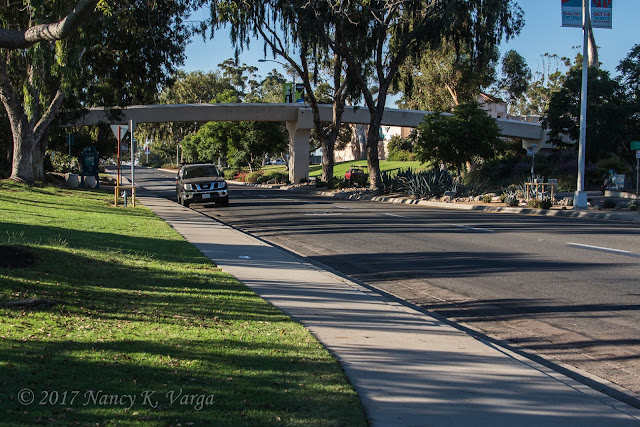My
hiking partners and I did an urban hike this past weekend. It started and finished in Balboa Park
but does not include any of the hiking trails within the Park. The object was
to visit seven small bridges located in the city. They are all located around
Balboa Park. I had visited both the Quince Street and Spruce Street Bridges in
the past and photographed them in 1993. I have crossed the Cabrillo Bridge many
times, and driven under it more times than I can count.
We
had an early morning start as there was a big Maker Faire going on in the Park and we
wanted to get a parking spot and avoid any crowds. We
were at the Park and starting out about 0815, and had no problem finding a
space. My husband, George, was going to be volunteering at the Natural History
Museum and was only about a half hour behind us. He was very lucky to get a spot
as the lots and Park Boulevard were almost full by 0845.
We
headed off with water as we were having a heat wave. (The high at our house was
104˚F!!!) Snacks or lunch would be found along the way at one of the many restaurants
we would pass.
The
first bridge was a pedestrian bridge that spans Park Boulevard and runs
East-West. It crosses over Park Boulevard and connects the Rose Garden and the Cactus Garden with the Prado area.
 |
| PARK AVENUE PEDESTRIAN BRIDGE |
After
walking through the Prado area we crossed the Cabrillo Bridge which spans
CA-163. This is a lovely tall 7 arched bridge which was was built for the 1915
Panama–California Exposition and
completed in 1914. It’s height is 120 feet and towers above the canyon floor.
 Photo by Peter Lerum Photography
Photo by Peter Lerum Photography
We
then proceeded West to First Avenue and turned North. The First Avenue
Bridge was built in 1931 in the mid-west, shipped to San Diego to be reassembled in place. It was built in response to the need
for a direct commuter route to offices in Downtown, the bridge aided the growth
of the Uptown district in San Diego after World War I. The historic steel
arch bridge is the only metal truss bridge in the City, and one of a handful
truss bridges located within the State.
 |
| FIRST AVENUE BRIDGE |
We continued North to the Quince Street
Bridge where we found the wooden-trestle bridge that was built in 1905 at a cost
of less than $1000 to allow easier access to the Fourth Ave. trolley station.
 |
| QUINCE STREET BRIDGE |
After crossing to Fourth Ave., we retraced our steps to Second Avenue and then
continued North to the Spruce Street Suspension Bridge.
The Spruce Street Bridge is located
in the residential Bankers Hill neighborhood and was built in 1912, and engineered by Edwin
Capps. This footbridge was initially designed to provide pedestrians a passage
across the deep canyon, to get between the new trolley lines built on Fourth
and Fifth Avenue. It now serves as a secret, serene, and very romantic spot,
beloved by locals and visitors to San Diego alike.
After
crossing this bridge we continued North to the Hillcrest neighborhood which is
vibrant and bustling. At several houses along the way there was some large metallic art. What fun!
There is a large variety of restaurants with enticing
smells to call you to them. We were attracted to Chocolat where we enjoyed varieties of chocolate gelatos. Chris
enjoyed Chocolate Spice, Myrna stayed with Dark Chocolate, and I enjoyed Dark
Chocolate Grand Marnier. We all enjoyed our choices. Then it was time to head
East to the Vermont Street Bridge.
 |
| YUM! CHOCOLATE! |
 |
| THIS IS REALLY GOOD! |
The Vermont Street Pedestrian Bridge
is a 420 ft. long steel and concrete pedestrian bridge spanning a canyon and
connecting two distinct San Diego communities, University Heights and
Hillcrest. The project includes surface
treatment of the concrete, creating images and text, and 28 laser cut stainless
steel and colored plexiglass railing panels with icons and quotations that refer
to the metaphors of time, walking, and bridging. Some of the quotations include
Dr. Seuss, Audrey Lourde, Irving Gill, Kate Sessions, Pythagoras, and Dr. Martin
Luther King, Jr.
We then proceeded to Georgia Street and then
headed South to the Georgia Street Bridge, another pedestrian bridge which spans
University Avenue between Park Boulevard and Florida Street. This bridge was built in 1914 by architect James Cromly. It
was designed to complement the theme of the 1915-16 Panama-California Exposition at
nearby Balboa Park. It became a key symbol and artery for residents because it
linked Hillcrest to North Park. The new bridge was an instant classic with its
elegant Roman arches, a theme echoed on the massive retaining walls on both
sides of University Avenue, below the bridge.
 |
| GEORGIA STREET CONSTRUCTION |
Regrettably
we were not able to cross on this bridge as it is being retrofitted and rebuilt
to meet the earthquake safety standards. As you can see it will be lovely once
again.
Once
we reached Park Boulevard we continued South to Village Place where we had left
our vehicle.
This
was a fun adventure. It was great to see and visit some of the neighborhoods
and admire their history and architecture. I would recommend this to anyone who
wants to explore the city on foot.






No comments:
Post a Comment